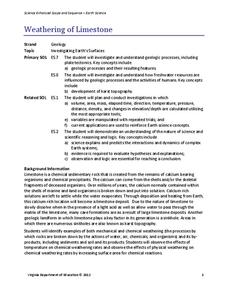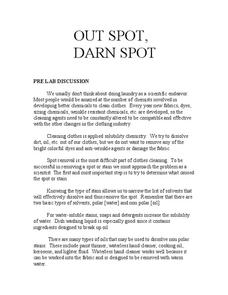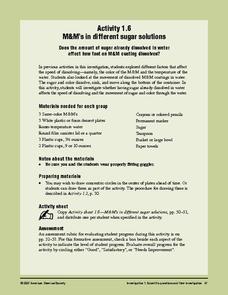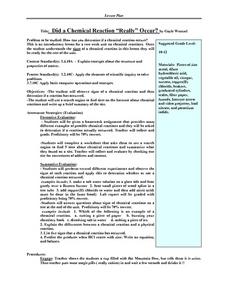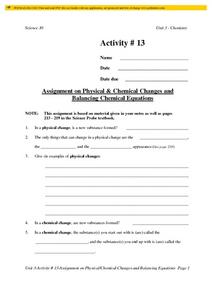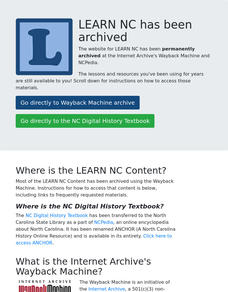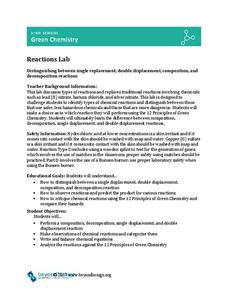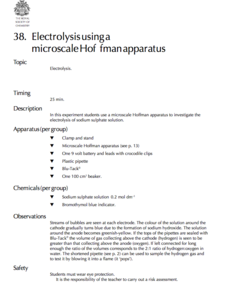LABScI
Freezing Point Depression: Why Don’t Oceans Freeze?
Can you go ice fishing in the ocean? Learners examine the freezing point of different saltwater solutions. Each solution has a different concentration of salt. By comparing the freezing points graphically, they make conclusions about...
Virginia Department of Education
Weathering of Limestone
We all know limestone weathers, but what affects the rate of weathering? Young scientists investigate the physical and chemical weathering of limestone (chalk) through experimentation. First, they conduct trials with different-size...
Serendip
Out Spot, Darn Spot
Encourage your classes to be laundry helpers! Learners explore the chemistry of stain removal with a lab investigation. By identifying the components of the stain, they identify the most effective solute for its removal.
Santa Monica College
Single and Double Displacement Reactions
If you aren't part of the solution, you are part of the precipitate! Young chemists learn about single and double displacement reactions including precipitation reactions, neutralization reactions, and gas forming reactions. They perform...
Nuffield Foundation
Making a Calibration Curve for Starch Concentration
How well can your class concentrate on solutions? Scholars use colorimeter absorption to explore a starch concentration calibration curve. They add iodine to different starch solutions to see how the concentration of the solution changes.
American Chemical Society
M&M's in Different Sugar Solutions
To conclude a mini unit on the dissolving of M&Ms® candy coating, this lesson investigates whether or not the concentration of sugar in the solvent affects the dissolving rate. Consider having older science learners write their own...
Curated OER
Chemical Changes to Matter
Students analyze the causes of corrosion. In this chemistry lesson, students investigate what is necessary to cause chemical changes in matter. Students discover the causes of rust and tooth decay.
Curated OER
Chemical Analysis and Stoichiometry
In this chemical analysis worksheet, students use a combustion analysis report to calculate the empirical formula for compound samples. This worksheet has 2 problems to solve.
Curated OER
Did a Chemical Reaction "Really" Occur?
Students perform several different experiments to observe signs of chemical reactions and determine if reaction has occurred, use search engine to find Internet sites pertaining to chemical reactions, and write up brief summary of site.
Curated OER
Physical and Chemical Changes and Balancing Chemical Equations
In this changes worksheet, students compare and contrast the characteristics of physical and chemical changes. Students practice balancing equations. This worksheet has 5 fill in the blank and 7 short answer questions.
Curated OER
Types of Chemical Reactions
Students conduct labs to gain an overview of chemical reactions. They observe examples of synthesis, decomposition, single displacement and double displacement reactions. They identify certain products by the use of litmus and splint tests.
Curated OER
Chemical Formula Writing Worksheet
In this chemistry worksheet, students practice forming the correct chemical equations for the twelve problems presented. The second page has the answers.
Curated OER
Follow Up Questions Lab 1-Chemical Reactions
In this chemical reactions worksheet, students answer follow up questions to a lab where they were observing chemical changes in reactions after mixing products such as hydrochloric acid and sodium bicarbonate. They answer six questions...
Curated OER
IB Chemistry 1-2 Fourth Quarter Practice Test
In this chemistry practice test worksheet, high schoolers review their knowledge of oxidation numbers, chemical reactions, and solubility as they answer 15 multiple choice questions.
Curated OER
Spontaneity, Disorder and Entropy
For this physical and chemical change worksheet, students calculate the entropy change involved in different chemical changes. This worksheet has 4 problems to solve.
Curated OER
Chemistry Jeopardy
In preparation for an introduction to chemistry exam, play Chemistry Jeopardy with your class. The categories include molar relationships, phases of matter, atomic structure, chemical nomenclature, and scientific investigation. If the...
Curated OER
Using the Spectrophotometer to Analyze a Mixture
General chemistry classes practice spectroscopy. They grasp the relationships between wavelength, absorbance, and solution concentration. Additionally, they gain valuable practice using laboratory equipment such as burets and pipettes....
Beyond Benign
Reactions Lab
You're bound to get a reaction from your classes with this experiment! Scholars perform several chemical reactions, make observations, and classify the reactions as single replacement, double replacement, composition, or decomposition...
Net Texts
Hess's Law Worksheet
Challenge young scholars' understanding of thermochemistry with this skills-practice worksheet on Hess's Law. Given a series of five multi-step chemical reactions, students must determine the overall change in entropy for each.
Royal Society of Chemistry
Electrolysis Using a Microscale Hoffman Apparatus—Microscale Chemistry
Get big results out of a small-scale lab! Young chemists observe the electrolysis of sodium sulfate using a microscale experiment. A colorful indicator solution combined with the production of gas bubbles yields a variety of observations...
McGraw Hill
Stellar Spectroscopy Interactive
Stars seem to be a far away mystery... but it turns out we know much more about stars than one would think! An engaging lesson shows learners how to read a light spectrum to determine the temperature and chemical makeup of a star. They...
Chemistry Collective
Virtual Lab: Cobalt Chloride and Le Chatelier’s Principle
Colorful cobalt complexes make a great way to learn about Le Chatelier! Eager chemists explore equilibrium through a virtual lab. Individuals use solutions with two different concentrations and observe the color changes that indicate...
Curated OER
Chemical Calculations
In this elements instructional activity, students use the relative atomic masses of given elements to calculate the relative formula mass. Students calculate the mass of compounds from given number of moles and determine the number of...
Curated OER
Does Size Matter?
Students explore chemical solutions. In this chemistry lesson, students investigate the relationship between three related experiments about solutions. Students determine variables that affect the chemical concentration of each solution.



